One day last summer I decided to take a hike by myself. We were vacationing in Samedan, Switzerland where my partner’s parents used to live. Samedan is a small village in the Engadin, the upper valley of the Inn river. In every direction there are stunning alpine trails. I love hiking there with my family more than anything in the world. But that day I needed to be by myself to exercise my body and clear my head.
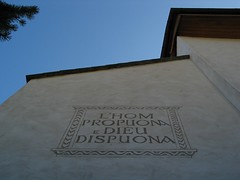
I started up the steep cobblestone road to my partner’s parent’s former house, still emblazoned in scraffito with the Romansch phrase her father had chosen: “Man proposes and God disposes.” [Wish you could see larger photos? Click on the images.]

As I passed by the house, my mind wandered through the apartment, holding the iron rail as I followed the curling stairway onto the stone floor, then padded into the Stüva (sitting room) and sat on the bench behind the slate table. By the time my mind was reacquainting itself with the mahogany music stand near Stuva’s the wood stove, I’d gone up the gravel road behind the house and almost reached San Peter, where dear Gaudi’s urn is buried.
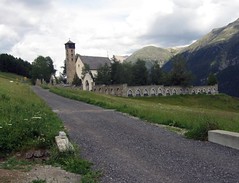
I opened the heavy iron gate and crunched across the pebbles to the cemetery’s inner wall, where simple square stone plaques hung. I found his and stood looking at the name carved in stone. My throat tightened. I began to cry. My tears were for the empty spaces his death has left in my partner’s and her mother’s lives. I mourned in anticipation of the loss I will feel, perhaps all too soon: my partner has cancer.
I wiped off my face, clunked close the gate and looked down into the large well filled with flowers that would become sweet mulch. The Swiss recycle everything, even urn burial spots, which one leases for 20 years at a time. I studied the intersection ahead, double checking the yellow sign for the direct route to Alp Muntasch so I wouldn’t waste gained altitude by having to double back. The gravel road turned to dirt and grass marked by tire ruts, then into a narrower path through the grass. Through the wooden cow gate and I was on the steep shaded path that began the hike proper. My heart began pounding against the pace I tried to maintain. I gave in, took out my camera, snapped some wildflowers and moved on. If I could keep up my heart rate, I’d be an altitude-trained terror on the soccer field when we got back to the States.
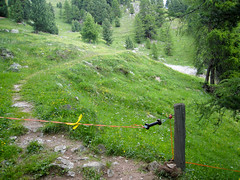
Sweat pouring off me, I hiked as though training for soccer, using intervals: walk fast enough to pant, relax the pace while hunting for a good flower specimen amongst hundreds, stop to take a few shots, and then off like a racehorse again. This would have driven my partner nuts–she chugs steadily along like the little engine that could, almost never stopping. I kept at my intervals until I reached the ubiquitous electrified fence. I unhooked the plastic handle, moved through, and hooked it back again. A friend of ours traveling with us had been outraged that there were no warning signs on these gates. How was a tourist to know not to touch the orange fabric tape? What kind of jolt might one suffer? Touching a fence once with his tail was enough to make our cousin’s dog shy away from electrified fences forevermore, but the shock certainly didn’t kill it. I assume it would just take once to teach a tourist too.
It was much too steep and the topsoil too fragile to climb straight up, so the trail switched directions back and forth, and always up. I moved in and out of shade as the trees grew more sparse. Shade passed over me as clouds moved across the dazzling blue sky. I kept taking my camera out of my pocket. I’d become obsessed by f-stops and macro-focus on my capable but simple point and shoot camera. Perhaps more of the flowers would have been in focus and the highlights not blown out if I’d let the camera think for itself.
At last, the grassy meadow below the hut where they served food and drinks lay before me. My stomach growled. I lay my bag on one of the picnic benches, put on my windbreaker, and surveyed the menu. After quietly practicing my rudimentary and poorly accented Swiss-German, I knocked on the window and politely ordered schwartz tee and apfel strudel. I have trouble with how to pronounce “I would like,” which seems to throw people off from the get-go. I sat down to read some articles on my iPad. A kid tore by on a tricycle. His mother brought me the black tea and apple strudel.
Ahh. This was the life.
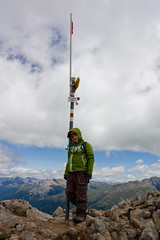
Then, sparse spits of rain on my iPad made me look up from reading news about that night’s US v. Sweden game in the Women’s World Cup. Off to my right was the Piz Padella. The first time my partner and I had made it to the top of the Piz, we’d gone because we had been told “it’s the family mountain: the village children just scamper up.” While the triumph of being atop the peak wiped our memories of the steep climb that was punctuated by sections with even steeper drop-offs, my fear and the pain in our knees on the way down is forever cemented in our memories. No one scampers up there, much less back down. We swore we’d never hike the “family mountain” again, but, for some reason we made our son do it with us a few years ago. Now all three of us are convinced: we’ll never hike up there again. Really.
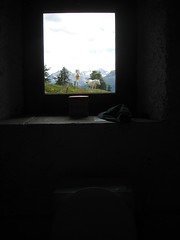
The gloomy clouds around the Padella reminded me to wipe off the drops on my iPad. It was time to go. A sign directed me into the barn to find the “vay-tsay” (WC, short for “water closet”), which had industrial strength door hinges I could barely move. Inside, there was a nice view out the window so I took a photo to add to my collection of windows. Doubtful that the “Danke” donation box on the back of the toilet was just a clever money-making operation run by the kid on the trike, I added 40 raps, then went back through the barn and onto the dirt road heading back to the trail head.
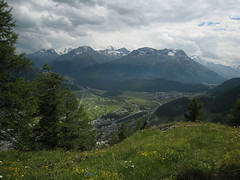
Despite the promise of rain, I passed the trail head to reach another beautiful view. (Not that there are many views in the Engadin that aren’t beautiful.) I’d initially planned to sit alone on this hill and read, but on the way up someone had been there eating his lunch. Nearly straight below was Samedan. There was the train station, its railroad tentacles reaching up and down the Inn valley and into the Val Bernina. There was the airport, taking a weather break from spawning sail planes. Small specks, hawks that our friends could have identified, soared high in the sky. Across the valley, atop the Muottas Muragl, was a hotel that used to be painted a muted pink that one could just pick out on the horizon. Now it was a stark, garish white, easily seen in the summer. On all of our visits over the years we’ve taken the Muottas Muragl Bahn (funicular) up to the hotel and taken one of the walking loops, or hiked to the town of Pontresina.
I heard a noise behind me. I turned expecting to find a fellow hiker, but instead found a horse. One of the ones I’d seen through the WC window, it was lazily munching grass in the way of my return to the trailhead. I am not wild about meeting large animals outside of their pens. I’d often had to dodge cows, sleeping or standing like boulders on the middle of a trail, under my partner’s protection. She loves Brown Swiss cows. As we pass by, she always mesmerizes them by murmuring softly how pretty they look and about what a nice day they must be having. I decided I’d just wait for this horse to move along. I sat down on one of two yellow benches placed there by the village, and pondered the darkening clouds.
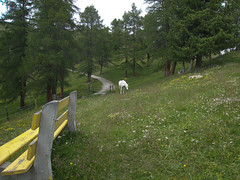
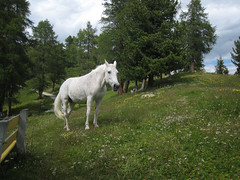
I turned in the direction of Samedan and went down the gentle slope into the grassy meadow. Would the horse continue to follow me? I turned around to check. It stood where I had left the road, looking at me. Was that a wistful look because it had lost another potential friend? Or, perhaps it was watching to be sure it had herded away the last hiker of the day. The farmers probably let the shepherd-horse out every afternoon so they could have a break from the tourists and get other work done.
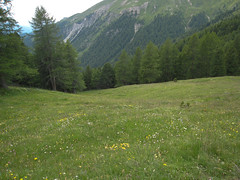
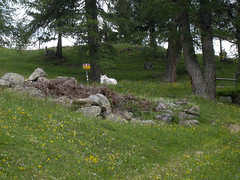
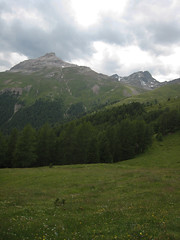
Satisfied I was free of the horse, I turned back, faced the Piz Padella, and worked on another photograph. I manipulated the settings on camera to lighten the scene enough to clearly see the mountain itself rather than the details of the clouds. My partner and I have always speculated that “padella” means knee cap, although the top doesn’t look much like a knee cap. With a knee cap like that, you could fight like a spurred rooster, but you definitely couldn’t play soccer.*
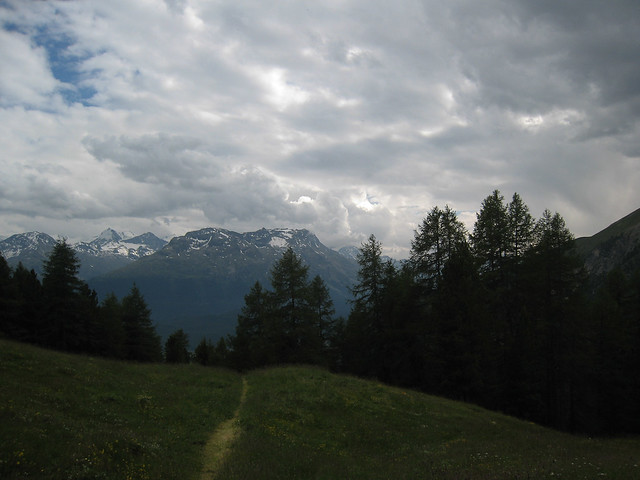
The dark clouds began to steadily spit rain, so I took one more picture before stowing my camera. I joined the narrow grassy path before me, jogging easily until I reached the trees and began the switchbacks. I kept a quick pace, loping along flatter sections, hopping over rocks and roots; walking gingerly across patches of loose chunks of gravel; and taking short, quadracep-bracing steps where it was steep. As the rocks and grass grew more wet, I took more care. I managed to avoid slipping until I’d reached the tire-tracked dirt road past the wooden cattle gate: I took long step down, placed my foot onto a rock hiding in a divit, and pushed my ankle sideways. I repeated a choice swear word over and over until it hurt a bit less. Then I resumed the descent with a limp timed to a monotonous but essential chant. “Watch where you step, be careful. Watch where you step, be careful.”
San Peter was in sight. A few couples strolled arm-in-arm under umbrellas. I paused chanting and greeted each with “gr&uum;ezi mitenand.” I reached the cobblestone street and headed for the village center, listening carefully for a car that might speed out from any turn. I usually don’t take very good care of my ailments. It’s more interesting to explain in pain-staking detail what hurts where to anyone who will listen. This time, for once, I decided that discretion might actually be the better part of valor. We only had a few more days in the Engadin and I wouldn’t have any fun if I couldn’t walk well.
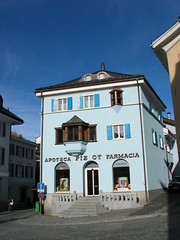
I went into the Apoteca to look for an ice pack. Personalized service is a hallmark of Swiss pharmacies, so I was forced to haul out my oft-used phrase: “Hello. I’m sorry–my Swiss-German is not so good. Do you understand English?” In a few stores, what follows is interchange of gestures, some Swiss-German words, some English words, and maybe a Spanish word thrown in for good measure. I actually enjoy these interactions. I like to exercise my Swiss-German and the multi-lingual Swiss are open to communication by any means. Switzerland, after all, has four official languages: French, German, Italian and Romansch. In the German-speaking areas, German counts as two languages: Swiss-German, which is a spoken but not written language, and high German.
In the Apoteca, the pharmacist’s assistant switched directly into perfect English, apologizing, of course, for not speaking it well. We examined a couple of boxes together. I selected one, paid, and exited with the customary cheery string of goodbyes. I continued down the street to the Bäckerei, where they prefer not to use their more limited English. At the counter, I asked for halb-weiss brot, and 200 grams of smelly Berg Käse.
My need to be alone fulfilled and my head cleared, I tucked my loaf of bread and package of cheese under my arm, walked across the street, and went into the apartment we had rented with our friends. I was ready to rejoin them, ready to be regaled with stories of their day’s adventures. I was back in that day’s present, back to experiencing life as it was happening.
*I have since learned that in Romansch, “padella” actually means “frying pan.”
For many more photos I’ve taken in Switzerland, go to my Flickr Swiss Travels collection.
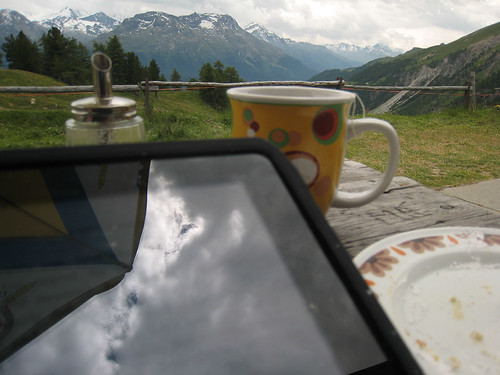
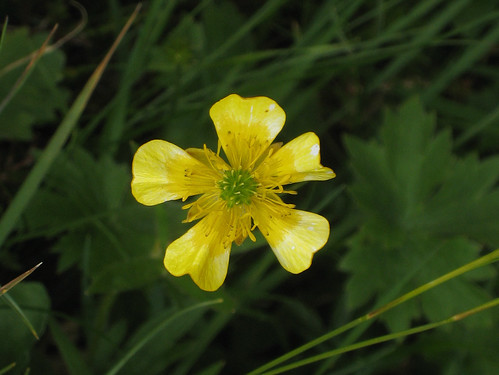

not many people can leave me speechless. this is a truly special journey that you have captured beautifully. your words come together to frame what it is to be in the moment. You have captured joy and vulnerability all at once.
thank you for writing this. it is a gift for me and all who read it.
karen
Okay, as the "outraged" friend, let me just say a few words in my defense; the ribbons I first encountered on the electric fence were multicolored, not caution orange, and, having grabbed an equally unmarked wire as a kid (it melted through my mitten), maybe I'm just a little bit sensitive. But I still think I was more surprised they didn't warn innocent tourists, than outraged.
Other than that, I really liked your description 🙂
-RMS